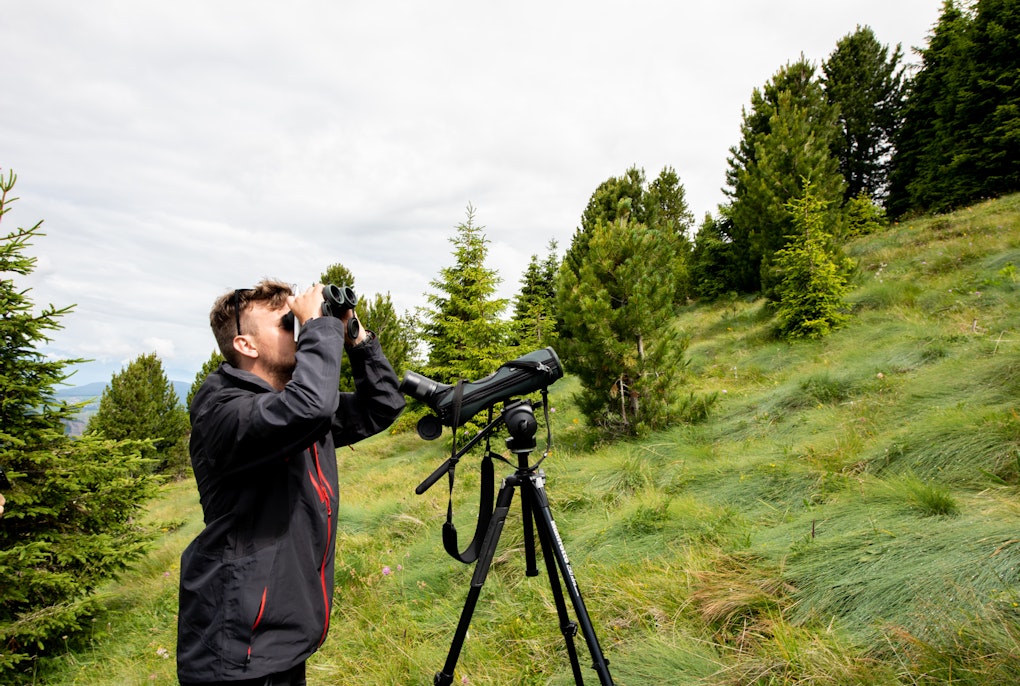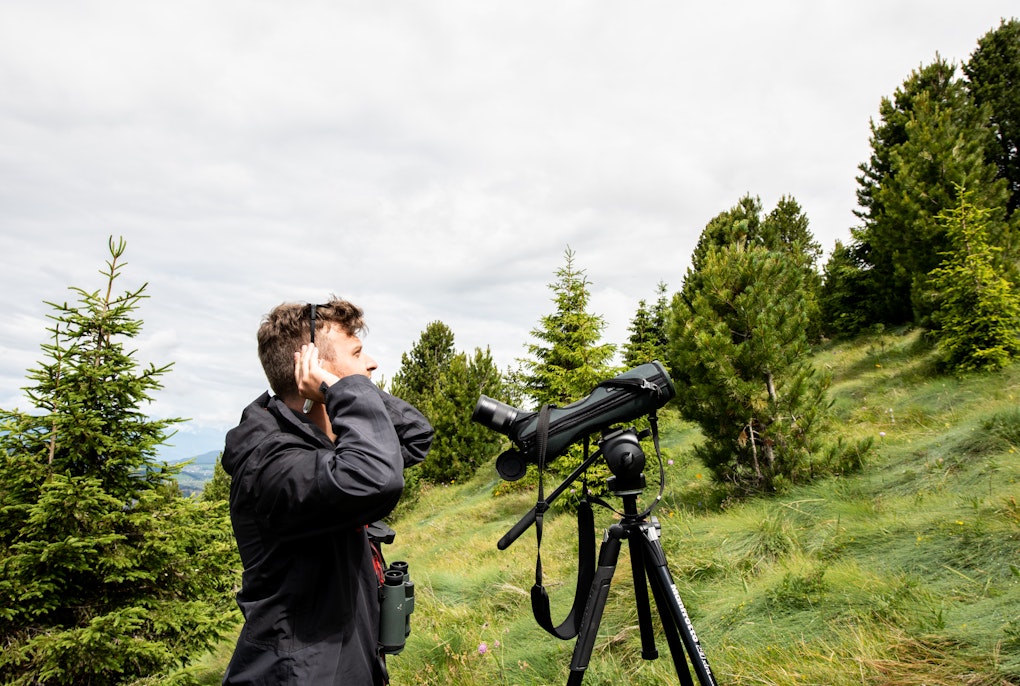Five hundred species of wild bees live in South Tyrol, each different in anatomy, ecology and behavior. Entomologist Lisa Obwegs is studying these diverse populations to assess the impact of human activities on their health status.
Think of a bee. What image comes to mind? You probably imagine a small, industrious insect with a segmented, black and yellow striped, fuzzy body with thin, transparent wings that vibrate as it flies from flower to flower, collecting pollen for its colony. Hard to go wrong: ask someone to describe a bee and, except in rare cases, this is what you will get back. Now, stretch your imagination. Think of bees other than those described above; invent new ones. They can be hairless, without their ‘classic’ stripes in other colors, with iridescent or golden fuzz, as big as your thumb or as small as a grain of rice, perhaps with very long antennae, with a tapered or stubby body. Let your imagination run wild, let it birth strange and unusual bees. Or, look more closely at what’s around you, take a walk on a spring day and sharpen your eyesight. Evolution has already done the work and there are more than a thousand species of bees in Italy, half of them found in South Tyrol. Human activities impact their populations, and entomologist Lisa Obwegs is trying to figure out how.
It's a sunny spring day, and a honeybee heads confidently toward the lavender flowers dotting the banks of the pond in the Eurac Research garden. The bee doesn't know it yet, but as it flies swiftly toward the aromatic shrubs, it has just violated someone else’s territory. When it is now inches away from its target, everything happens in the blink of a wing: another bee swoops, preventing it from reaching its target. The honeybee changes course, while the other bee returns to its patrol. The “defender” is different from the honeybee, and even an untrained eye would notice the stockier body with yellow bands interrupted by black patterns on its abdomen making it look like a wasp. Meet Anthidium florentinum, one of about 500 species of wild bees living in South Tyrol. The males of this species possess sharp protuberances on their abdomen, with which they attack other bees that dare to get too close to the flowers from which the females collect pollen.
Anthidium florentinum, one of about 500 species of wild bees living in South Tyrol. The males of this species possess sharp protuberances on their abdomen, with which they attack other bees that dare to get too close to the flowers from which the females collect pollen.
One of the characteristics that vary greatly from one species to another is sociality. The Apis mellifera are the species we are most used to seeing – because it is bred to produce honey, forms colonies consisting of a queen and thousands of worker bees. The queen lays eggs, while the workers – her daughters – are in charge of caring for new generations and protecting the nest. Unlike Apis mellifera, Anthidium florentinum is a solitary bee, as are 75 percent of wild bee species. The sociality of each species, however, has variations. Some solitary species are gregarious, meaning they all lay their eggs in the same nest in the ground, although they do not form a true colony. Each bee builds its own cells, lays its eggs there, deposits pollen to feed the larvae, and then dies. This new generation of bees, therefore, will never meet the bee that gave birth to it. Still other species form colonies and exhibit some degree of division of labor. Unlike honeybee colonies, however, colonies of these species last only one year. All members of the colony die in the fall, except for fertilized females who after having wintered, will establish a new colony the following year.
Not all wild bees lay their eggs in the nest they themselves have built: some take advantage of others’ efforts. Nomada flava, a wasp-like looking bee, is one such parasitic species. Nomada flava females station themselves near the nest of other wild bee species waiting for the original “homeowners” to move away. As soon as they have a chance, then, they sneak into the unattended nest, destroy the host’s eggs or larvae and deposit their own there. Once hatched, Nomada flava larvae will then be able to feed on the nourishment that was intended for the offspring of the parasitized species.
Parasitic species are very useful to those involved in assessing the conservation status of wild bees. Indeed, the presence of numerous individuals of a parasite species in an area indicates that the population of the parasitized species is also healthy. Then again, if there were not many nests to be parasitized, there could not be as many individuals of the parasitized species. Researchers and researchers, therefore, can assess the health status of both species by observing only one.
What varies between wild bees, in addition to anatomy and sociality, are their feeding preferences. Adults feed on nectar from a wide variety of plants, while larvae feed on pollen. There are species that draw pollen from many different plant species, such as the bumblebees of the Bombus pasquorum species, and others that are very selective, such as Chelostoma florisomne, which feed on plants of the Ranunculus genus. Some bees even feed on the pollen of only one or two species, as in the case of Macropis fulvipes, which specialises on a couple of plants of the Lysimachia genus.
Why is there such a diversity of wild bees in South Tyrol? The answer lies in the enormous variety of environments that can be encountered in the province. “In South Tyrol, we go from almost 4,000 m.a.s.l. in the Ortles Mountains to the plains. The large altitudinal range of this province makes it a suitable territory to host many species with different needs and habitats,” explains Lisa Obwegs, a doctoral student at the University of Innsbruck and Eurac Research's Institute for Alpine Environment. “Just for comparison, consider that there are about 600 species of wild bees living in the entire country of Germany, only 100 more than in South Tyrol.” Lisa counts the wild bee species found in South Tyrol and estimates their abundance. To do this, she has to capture a number of individual species in a variety of environments: mountain meadows, pastures and urban flower beds. “The only way we can identify the bees is to capture some of them, take them to the lab and add them to our entomological collection. This collection, in addition to having a negligible impact on natural populations, is a useful tool for analyzing biodiversity and its changes over time, as well as for bringing young and old closer to the world of wild bees during outreach events,” Lisa explains. The question Lisa would like to answer is: what impact do human activities have on wild bee populations? Lisa is particularly interested in investigating the role played by land use, i.e., grazing, mowing and fertilizing the land on which the plants frequented by bees grow. “What I expect is that in areas where soils are more exploited, bee diversity will be lower and land use will have changed the composition of the communities.”
Several studies show that insects are in decline globally, and within this less-than-reassuring picture, there is no reason to think that South Tyrolean wild bees are any exception. To know for sure, however, we need data. “In Italy, to date, the health status of about a hundred species of wild bees is known, which is less than a tenth of all species on the peninsula,” says Lisa Obwegs. “Despite this, we already know what the potential threats to the conservation of these animals are.” As Lisa explains, habitat loss, land-use intensity, pesticides and climate warming are the main factors that threaten the survival of certain species. But there is more. Wild bees compete for resources with domestic bees, which are used for honey production, and this sometimes poses a problem. Honeybees live in very large colonies and, because of this, are able to gather many more resources than a solitary wild bee. In some cases, therefore, domestic bees can drastically reduce the amount of resources available to their wild counterparts. Wild bees need suitable nesting sites and materials to build their nests, as well as plants from which to collect pollen, all within a distance of a few hundred meters. If one of these resources is lacking in a wild bee’s territory, the entire colony is in danger. “It is essential to regulate the number of domestic bee hives and the places where they are situated. A good compromise between the need to produce honey and the need to safeguard wild bees is not to place hives in protected natural areas, such as parks and reserves,” Lisa explains.
Wild bees form a group that is as multifaceted as it is valuable. Their presence is both a requirement and an indication of a healthy environment. Thanks to their activity as pollinating insects, thousands of plant species can reproduce and continue to exist. Wild bees, however, are also very sensitive to changes and, for this reason, must be monitored and, first and foremost, known. In this regard, the work done by Lisa Obwegs is crucial. The data Lisa collects will, in fact, come in handy in the creation of a future red list of South Tyrolean bees. A small step on the path that will hopefully lead us into a future where we will still be able to observe the myriad of different forms a bee can take.
And now, think of a bee.
The project
Lisa Obwegs' PhD is financed by the Südtiroler Sparkasse Foundation.






